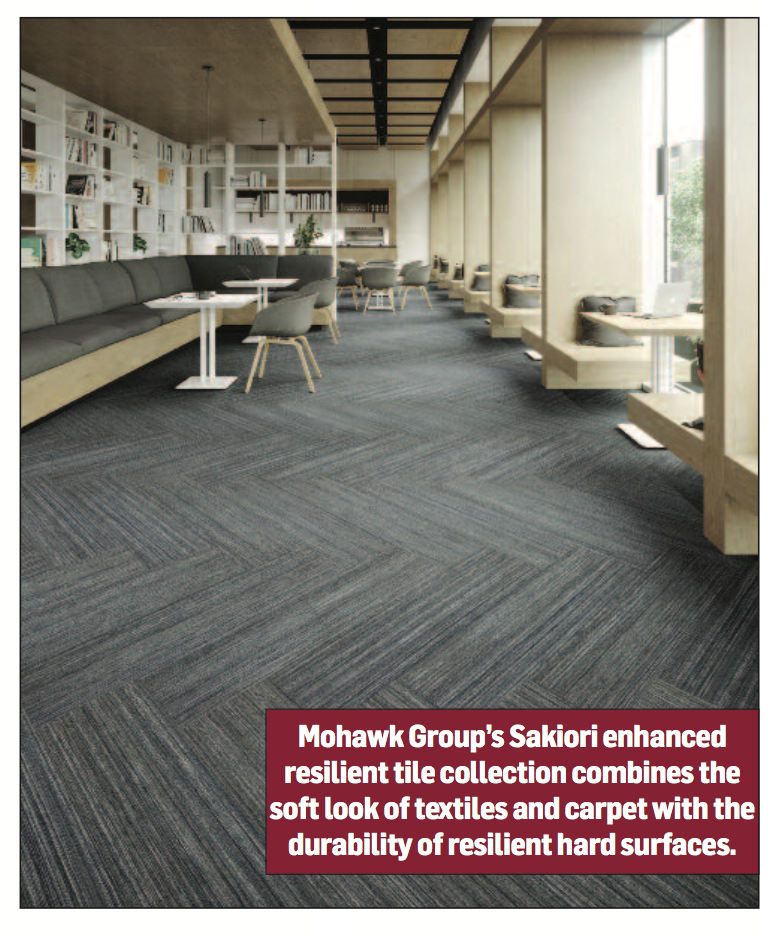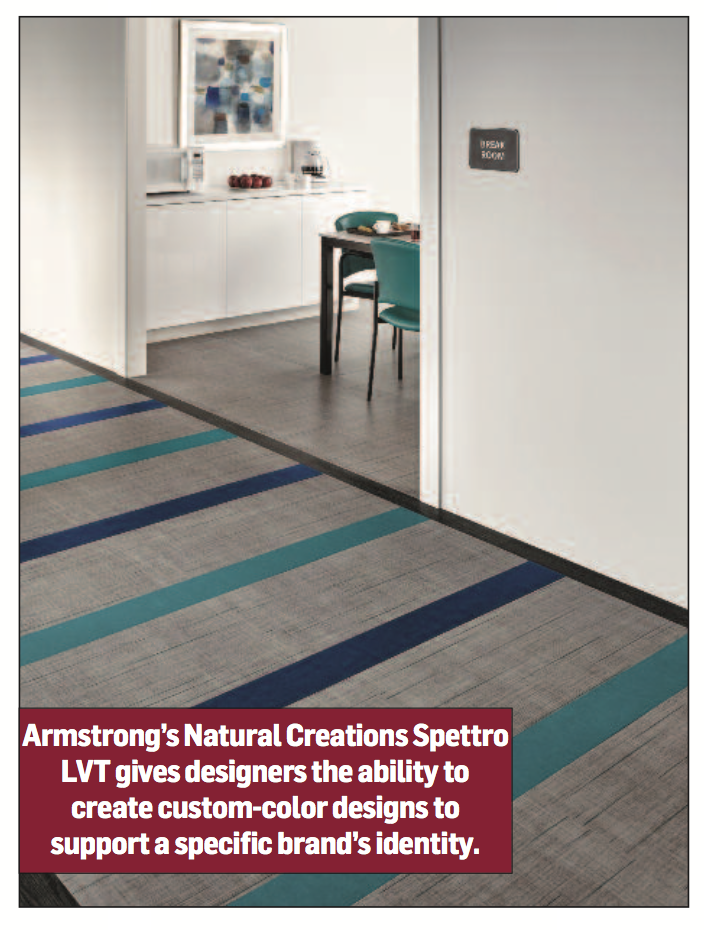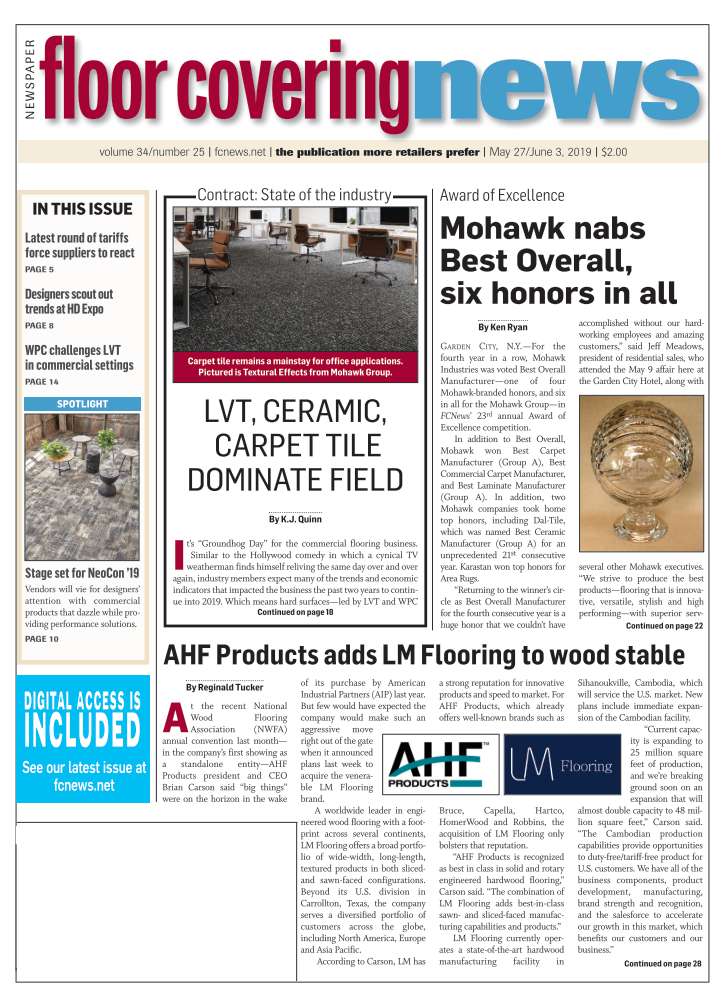May 27/June 3, 2019: Volume 34, Issue 25
By Lindsay Baillie
 It’s well documented that WPC continues to take market share from other resilient flooring options—as well as competing hard surfaces—specifically in the residential market. Now we are witnessing a battle for share in commercial applications.
It’s well documented that WPC continues to take market share from other resilient flooring options—as well as competing hard surfaces—specifically in the residential market. Now we are witnessing a battle for share in commercial applications.
This trend shows no signs of slowing down as flooring executives, such as Thomas Baert, president, CFL Flooring, predict WPC and other rigid products will continue to expand their reach. “Many companies have been focusing on WPC versions of multi-layer flooring,” he stated. “For us, SPC is the next logical step in the evolution of multilayer flooring in both residential and commercial applications”.
Despite WPC’s aggressive growth in the residential arena, flooring manufacturers say the red-hot product is not likely to cannibalize traditional LVT in the commercial realm. This is partly because certain issues found in commercial projects are better solved with glue-down applications than WPC.
“One of the biggest challenges with WPC—or any rigid core—is the installation in commercial settings,” said Adrienne Roseman, director, LVT marketing, Tarkett North America. “Traditional locking mechanisms present installation challenges when it comes to heavy rolling loads or rolling loads with pivot points.”
What’s more, according to observers like Amy Tucker, senior marketing manager, Philadelphia Commercial, WPC is more susceptible to dents from chair legs or divots from high-heel shoes, unlike traditional glue-down LVT or glue-down SPC.
However, that is not to say WPC doesn’t have a home in commercial. “From a durability and performance standpoint, rigid core products are suitable for hospitality, retail, corporate and some education uses,” Roseman noted. “They are easy to install and have the durability to stand up to heavy foot traffic.”
Rick Morris, vice president of commercial, USFloors, sees WPC thriving in living environments such as multi-family, student housing, senior living as well as hospitality. “The key reason for this growth is speed of installation compared to traditional LVT, thereby allowing clients to return to revenue generation faster. WPC [also] offers superior IIC qualities than traditional LVT using separate underlayment. Because WPC floats, it does not destroy subfloors when removed—something that is valued during the replacement cycle. It also feels better under-foot than traditional LVT and is often mistaken for real wood.”
Karndean Designflooring is also seeing WPC creep into the multi-family sector. “While the total square footage of these jobs is on par with other commercial projects, the floors themselves are being laid in smaller spaces, thereby eliminating the need for transitions,” Milton Goodwin, vice president of commercial sales, explained.
Others point to WPC’s appeal in commercial applications from a suitability perspective, especially hospitality. “It’s a lighter-traffic application,” said David Thoresen, senior vice president of commercial hard surface, Mohawk Group. “If you look at a hotel room, you basically have an advanced heavy residential application. It really doesn’t come as a surprise that it would work adequately in there.”
While WPC has made its way into certain commercial sectors, manufacturers say it represents only a small share of the commercial resilient market. “When you move from LVT to WPC, you would do so to solve a specific challenge,” said Kurt Denman, chief marketing officer and executive vice president of sales, Congoleum. “Otherwise, you would be adding features—and cost—that are not necessarily needed for that project.”
 According to Denman, a WPC product may be specified over an LVT floor if there are subfloor imperfections (which a rigid base could help mask). Or, for example, if there is a need to mitigate sound transfer between floors, WPC’s integrated backing may make it a better choice. “At the same time, the click profile may allow the product to float, but that type of installation is not well suited to commercial environments,” he added. “And gluing a click profile adds a layer of complexity to the installation.”
According to Denman, a WPC product may be specified over an LVT floor if there are subfloor imperfections (which a rigid base could help mask). Or, for example, if there is a need to mitigate sound transfer between floors, WPC’s integrated backing may make it a better choice. “At the same time, the click profile may allow the product to float, but that type of installation is not well suited to commercial environments,” he added. “And gluing a click profile adds a layer of complexity to the installation.”
Traditional glue-down LVT is expected to remain king in several commercial sectors such as healthcare, education and budget-conscious multi-family projects. “Standard glue-down LVT offers the ability to meet lower product budget thresholds and some of the above-mentioned sectors still lend themselves to preferring a glue-down floor,” said Jeremy Whipple, vice president of commercial business development, Novalis. Reesie Duncan, vice president, global design, Shaw Contract, agrees. “There are definitely some segments that are embracing the performance attributes of WPC, but we predict the higher performance environments will still have a place for traditional glue-down LVT. Healthcare and education are holding strong with traditional glue-down LVT due to important performance attributes, for example rolling and static loads.”
Karndean’s Goodwin sees flexible LVT also holding ground in commercial settings such as restaurants and areas with high potential for slipping. “Specifiers want to ensure that the planks or tiles stay in place by fully adhering them to the subfloor,” he explained.
LVT’s glue-down capabilities make it ideal for many commercial applications. “In situations with heavy rolling loads, a glue-down LVT will be necessary to endure the weight of a load,” Tarkett’s Roseman noted. “Because a traditional LVT would be glued down in those situations, the risk of significant weight damaging a click system or causing indentation on WPC is mitigated.”
The wild card
While WPC is known for stealing market share from other resilient products in the residential sector, manufacturers say the sub-category may get a dose of its own medicine in commercial. The main culprit? SPC, which boasts a denser core and greater dimensional stability.
Yon Hinkle, director, product design and innovation, Armstrong Flooring, sees rigid core flooring like SPC being used in a wide range of light commercial applications, including flooring for medical and dental practices, accounting or law firms, restaurants, local retailers, daycare centers as well as public places like libraries and museums. “Rigid core is an innovative hybrid product that combines some of the best features from multiple flooring categories, and so we’re likely to see it being used more often in commercial spaces for a variety of reasons,” he explained.
Mohawk Group also sees the value of SPC over WPC in commercial settings. “WPC has really maxed itself out in the commercial arena,” Thoresen said. “We have found rigid vinyl products have a better story, and we’ve launched a couple of those. But we actually took a pass on WPC for commercial. While we know people are using it, we just don’t feel the attributes really warranted going into all commercial environments.”
Despite SPC’s threat to WPC, manufacturers agree there will always be a market for LVT and WPC products. “Designers and building owners will choose the product that best suits their needs based on multiple factors including design, performance attributes, schedule and budget,” Armstrong Flooring’s Hinkle explained.

